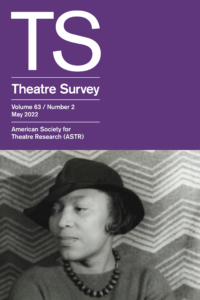Theatre Survey, 63.2
 Opening section
Opening section
Bradley Rogers’s The Song Is You: Musical Theatre and the Politics of Bursting into Song and Dance begins with My Fair Lady’s showstopping number “The Rain in Spain,” in which Eliza Doolittle, Henry Higgins, and Colonel Pickering burst into song and dance, performing a tango, mimicking a matador and bull, and clicking their heels and shouting “Viva!” Rogers points out, early in the Introduction, that in this Lerner and Loewe show, supposedly an exemplar of the integrated musical form, the number does nothing to advance the show’s story. Indeed, as Rogers notes, Eliza has been attempting to imitate Higgins, but as soon as she does this successfully, pronouncing “the rain in Spain stays mainly in the plain” the way Higgins pronounces it, the three characters burst not only into song and dance but into “another imitation,” in this case of their “kitschiest fantasies of Spain” (3). For Rogers, this moment is illustrative of “the logic central to all musicals: the transitive force of musical imitation, with one imitation prompting yet another, bodies imitating other bodies, all unleashed in the moment of bursting into song” (3). The Song Is You takes this as its key problem—the question of how musicals imitate the bodies of others, how they ask us in the audience to imitate them, and what these multiple copies, these mimetic performances of song and dance, have to teach us about how musicals imagine subjectivity as such.
Central to The Song Is You is a revision of the commonly held wisdom that “musicals burst into song when words will no longer suffice to carry the emotion” (5). Rogers modifies this claim to argue “that musicals burst into song—and dance—when one body will no longer suffice to carry the emotion” (5). In many ways this is a revision, too, of Scott McMillin’s The Musical as Drama (2006), which claims that characters are doubled and sometimes tripled while singing and dancing—during what McMillin calls “lyric time.” Rogers’s point here emphasizes the way that musicals disperse the character not only through the lyrical multiplication of character traits but through the characters’ performances of identification across, most important, race, ethnicity, and gender. The Song Is You gives us repeated examples of musicals in which characters identify improbably across race and ethnicity by accessing what Rogers calls the “exotic/erotic dynamic,” which, he argues, “points us toward the essential psychic operations of musical theatre—ones that involve performance across different types of bodies” (120).


